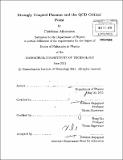| dc.contributor.advisor | Krishna Rajagopal and Hong Liu. | en_US |
| dc.contributor.author | Athanasiou, Christiana | en_US |
| dc.contributor.other | Massachusetts Institute of Technology. Dept. of Physics. | en_US |
| dc.date.accessioned | 2012-01-30T16:56:04Z | |
| dc.date.available | 2012-01-30T16:56:04Z | |
| dc.date.copyright | 2011 | en_US |
| dc.date.issued | 2011 | en_US |
| dc.identifier.uri | http://hdl.handle.net/1721.1/68867 | |
| dc.description | Thesis (Ph. D.)--Massachusetts Institute of Technology, Dept. of Physics, 2011. | en_US |
| dc.description | Cataloged from PDF version of thesis. | en_US |
| dc.description | Includes bibliographical references (p. 171-186). | en_US |
| dc.description.abstract | In this thesis, we begin by studying selected fluctuation observables in order to locate the QCD critical point in heavy-ion collision experiments. In particular, we look at the non-monotonic behavior as a function of the collision energy of higher, non-Gaussian, moments of the event-by-event distributions of pion, proton and net proton multiplicities, as well as estimates of various measures of pion-proton correlations. We show how to use parameter independent ratios among these fluctuation observables to discover the critical point, if it is located in an experimentally accessible region. We then begin our investigation of the properties of quarks and baryons which live in the strongly coupled plasma of certain gauge theories which are similar to QCD using the AdS/CFT correspondence. We first study the velocity dependence of the screening length, L,, of Nc quarks arranged in a circle (a "baryon") immersed in the hot plasma of strongly coupled A = 4 super Yang-Mills theory moving with velocity v. We find that in the v --+ 1 limit, L, oc (1 - v2 )1/ 4 /T, which provides evidence for the robustness of the analogous behavior of the screening length defined by the static quark-antiquark pair. Finally, we compute the energy density and angular distribution of the power radiated by a quark undergoing circular motion in the vacuum of any conformal field theory that has a dual classical gravity description and many colors. In both the strong and weak coupling regimes, the angular distribution of the radiated power is in fact similar to that of synchrotron radiation produced by an electron in circular motion in classical electrodynamics: the quark emits radiation in a narrow beam along its velocity vector with a characteristic opening angle a - 1/Y. This jet-like beam of gluons opens a new way of modeling jet quenching in heavy-ion collisions. | en_US |
| dc.description.statementofresponsibility | by Christiana Athanasiou. | en_US |
| dc.format.extent | 186 p. | en_US |
| dc.language.iso | eng | en_US |
| dc.publisher | Massachusetts Institute of Technology | en_US |
| dc.rights | M.I.T. theses are protected by
copyright. They may be viewed from this source for any purpose, but
reproduction or distribution in any format is prohibited without written
permission. See provided URL for inquiries about permission. | en_US |
| dc.rights.uri | http://dspace.mit.edu/handle/1721.1/7582 | en_US |
| dc.subject | Physics. | en_US |
| dc.title | Strongly coupled plasmas and the QCD critical point | en_US |
| dc.type | Thesis | en_US |
| dc.description.degree | Ph.D. | en_US |
| dc.contributor.department | Massachusetts Institute of Technology. Department of Physics | |
| dc.identifier.oclc | 773206183 | en_US |
